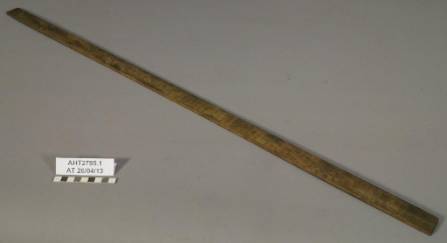Author: Sue
Date: 7 May 2013
Temperature: -41 degrees C
Wind Speed: 10 knots
Temp with wind chill: -55 degrees C
Sunrise: n/a
Sunset: n/a
In our conservation work on the artefacts from the explorers' huts here in Antarctica we often get little surprises. As we inspect each artefact very closely in the pre-treatment process of documenting its materials, construction and condition, we come across little details that may not have been immediately obvious to those AHT conservators who, in the summer months, catalogued and packed up the artefacts in the huts and transported them here to us in the lab at Scott Base.
Physics lab in Scott's Hut
I had one such delightful little surprise recently. I un-wrapped an artefact that bore the description "wood slat, approx. one metre long", which had been located under the physics bench in Captain Scott's Terra Nova hut, from the 1910-13 British Antarctic Expedition. As I inspected it I noted that it was, in fact, exactly one metre long, was made of oak, and was covered on one side and one edge with a heavy layer of black soot. Part of our approach to conserving the artefacts is to preserve all evidence of use, and this includes preserving those soot layers that tell of the items' long history around the blubber-and-coal fuelled stoves inside the huts. But occasionally the soot is also hiding information, so we investigate a little further and may find a good reason to remove or at least reduce it. Such was the case with the "slat" as, when I did, I revealed a very neat metric (one-metre) rule, or scale, with hand-written pencil numbers "10" through "90" at ten-centimetre intervals. Nice!
Detail, 30cm - 50m
And quite interesting, too, as Britain (and, for that matter, Canada, from where the Terra Nova physicist 'Silas' Wright hailed) was still using the imperial system of measurement until much much more recently... although scientists are always well ahead of their times!
One-metre oak rule, after treatment



